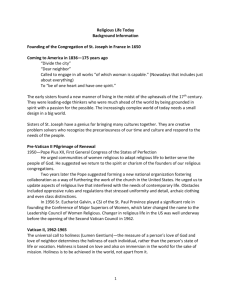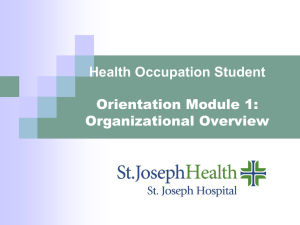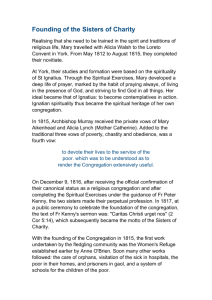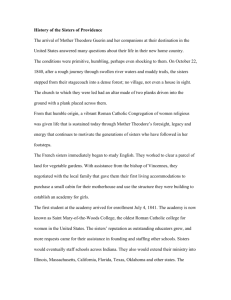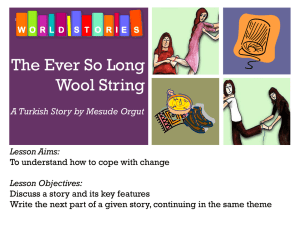CSJA Orientation, History, Mother St John.doc
advertisement
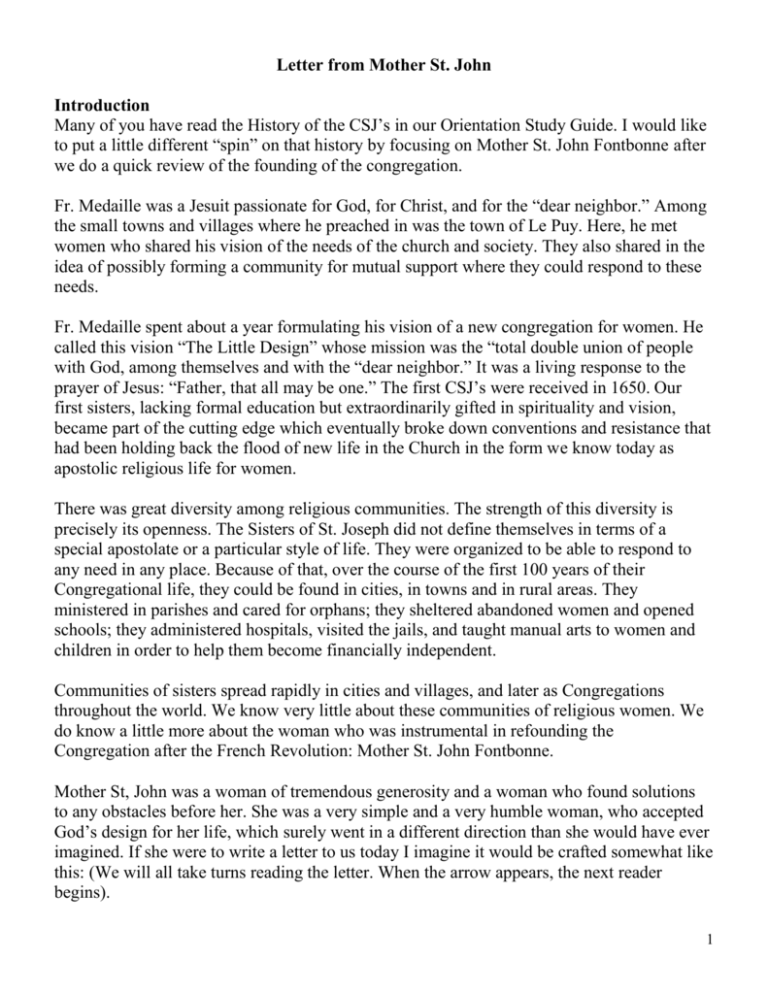
Letter from Mother St. John Introduction Many of you have read the History of the CSJ’s in our Orientation Study Guide. I would like to put a little different “spin” on that history by focusing on Mother St. John Fontbonne after we do a quick review of the founding of the congregation. Fr. Medaille was a Jesuit passionate for God, for Christ, and for the “dear neighbor.” Among the small towns and villages where he preached in was the town of Le Puy. Here, he met women who shared his vision of the needs of the church and society. They also shared in the idea of possibly forming a community for mutual support where they could respond to these needs. Fr. Medaille spent about a year formulating his vision of a new congregation for women. He called this vision “The Little Design” whose mission was the “total double union of people with God, among themselves and with the “dear neighbor.” It was a living response to the prayer of Jesus: “Father, that all may be one.” The first CSJ’s were received in 1650. Our first sisters, lacking formal education but extraordinarily gifted in spirituality and vision, became part of the cutting edge which eventually broke down conventions and resistance that had been holding back the flood of new life in the Church in the form we know today as apostolic religious life for women. There was great diversity among religious communities. The strength of this diversity is precisely its openness. The Sisters of St. Joseph did not define themselves in terms of a special apostolate or a particular style of life. They were organized to be able to respond to any need in any place. Because of that, over the course of the first 100 years of their Congregational life, they could be found in cities, in towns and in rural areas. They ministered in parishes and cared for orphans; they sheltered abandoned women and opened schools; they administered hospitals, visited the jails, and taught manual arts to women and children in order to help them become financially independent. Communities of sisters spread rapidly in cities and villages, and later as Congregations throughout the world. We know very little about these communities of religious women. We do know a little more about the woman who was instrumental in refounding the Congregation after the French Revolution: Mother St. John Fontbonne. Mother St, John was a woman of tremendous generosity and a woman who found solutions to any obstacles before her. She was a very simple and a very humble woman, who accepted God’s design for her life, which surely went in a different direction than she would have ever imagined. If she were to write a letter to us today I imagine it would be crafted somewhat like this: (We will all take turns reading the letter. When the arrow appears, the next reader begins). 1 I imagine if Mother St. John were to write a letter summarizing her life, it would read something like this: My beloved daughters and sons, I know you are all curious about me and my life. I did not leave you a great written legacy-no long epistles to my daughters, as they went from village to village, diocese to diocese, country to country. I write this letter to tell you about myself with supreme humility and with great love and awe for all of the work you are doing for “the dear neighbor.” I was born on March 31, 1759 in Bas-en-Basset, France; I was baptized on that very same day. My parents were fervent Catholics—God held first place in my family. I grew up enveloped by the great love of God. As a young girl, people said I embodied these characteristics: Lively spirit Pleasant character Special openness to God Strong will Good judgment Kind heart A woman of influence I was very close to my sister Marie who was two years older than I. We were educated by the Sisters of St. Joseph in Bas-en-Basset. I loved to organize games and settle minor conflicts; I also took classes seriously. Even though Marie was two years older, she would tell the other children, “Go to Jeanne—she will take care of everything.” I was gifted with sound judgment and common sense beyond my age. My aunt, Sr. St Frances, was a CSJ and Marie and I attended many ceremonies at the local convent. We loved going to the convent because we felt we “prayed better there.” We would pray and talk with the sisters and attend spiritual talks and conferences; in this fertile ground the seeds of vocation were planted. Marie and I confided to our aunt the desire to enter religious life. Sr. St. Frances wanted to test the quality of our vocation so she painted a sordid picture of religious life. I told Marie “we have to be better to receive this grace.” We grew even more determined to pursue our vocation and we remained fervent, joyful and faithful to this call. In 1778 Marie and I attended a ceremony for the reception of the religious habit. Bishop de Galard, Bishop of Le Puy, presided during the liturgy. We were awed by such a beautiful ceremony and we were oblivious to the fact that the Bishop noticed our piety and reverent demeanor. He asked Sr. St. Frances to open a novitiate and to bring us as postulants! What 2 joy leapt in my heart when the Bishop said of me: “Form this little one well. She will be the glory of your congregation.” I spoke with my parents who graciously accepted the sacrifice God was asking them to make by giving Him their daughters. On July 1, 1778 we were on their way to the novitiate in Monistrol-sur-Loire. During the novitiate I developed the gifts God so richly gave me: Serenity Kindness Sound Judgment Cheerfulness Zeal Humility Availability to others I felt nourished by the rich spirituality offered through the Constitutions of the Sisters of St. Joseph and the words of Fr. Medaille: “each member should, according to the Design, always have the fullness of the Holy Spirit in her heart and since the Congregation itself professes to be one of the most pure and perfect love, she will find much to imitate.” On October 14, 1779 Marie and professed our first and final vows and I took the name Sister St. John. I wanted to shout to the heavens: “Let us love one another, my dear Sisters; it is so good to love! Moreover, it is the law of the Lord.” When I was 26 years of age, Bishop Galard asked me to become the Superior of the congregation in Bas-en-Basset. Mother St. Frances objected saying that I was much too young and there were older sisters who were qualified for this position. The Bishop upheld his decision and left the choice of a new superior to the Chapter. I was elected even though I did not feel competent; in obedience I accepted. As my love for God increased, my love for others, the “dear neighbor” also increased. I recognized that the youth and the women in the city needed spiritual guidance so I conceived the idea of creating a working center that would attract both groups. With the help of a gracious benefactor and the center became a reality. A Christian attitude permeated the working center and was felt throughout the city. The attitude of the people changed and Christian living radiated. While the Christian attitude in the working center was thriving, a profound malaise was evident in society, especially among the poor. New ideas propagated by freethinkers and freemasons seeded doubt and began a movement that would change the life of the entire country bringing about immense suffering. This was the dawning of the French Revolution, a very dark period in my life. In the eyes of the revolutionaries, Christianity was seen as an 3 obstacle to human happiness and therefore they believed both Church and Christianity must be abolished. During this time religious life was profoundly disrupted. I firmly believed that we must remain invincibly faithful and attached to the true Faith and no violence would ever separate us from this Faith. I was filled with deep sorrow when my community was forced to disband. A handful of us remained to continue the work of the community in secret until we also were eventually forced to abandon our good works, return to home and go into hiding. One day, when priests were hiding in our home, a group of revolutionaries arrived looking for the sisters. Rather than risk exposing the priests we surrendered; we were handcuffed and taken to prison. We knew death was a possibility and we helped each other face it in a spirit of faith. To give one’s life for Jesus Christ—what a privilege! When I was told I would be executed tomorrow, I exclaimed, “Deo gratias!” After spending all night in prayer, the day we longed for arrived. Suddenly the door opened. The guard rushed in shouting: “Citizens, you are free! Robespierre is dead! The guillotine is abolished!” Most of the prisoners were filled with joy but we were saddened we would not get to meet our loving God. I was sad that we were not worthy to die for our holy religion. The day was July 27, 1794. At the dawn of the Napoleonic Era, on Easter Sunday, 1802, the church bells of Notre Dame de Paris pealed in celebration of the return of Catholic worship in France! Joseph Fesch, uncle of Napoleon, became the Archbishop and Cardinal of Lyon. He saw in his diocese and elsewhere the ruins in the aftermath of the French Revolution. How could he alleviate all this misery? Established groups of religious women no longer existed and there were too few priests. Children, young girls, families, the poor, the sick, the dying, all were in need of care and evangelization. Cardinal Fresch was mindful of a group of 12 women called the Black Daughters” (named so because of the black dress they wore) who wished to form a religious community as soon as civil law allowed. However he did not envision a contemplative lifestyle; he wanted someone who could form these young women in the spirit and service of St. Joseph without diminishing their desire for holiness as contemplatives. You can only imagine my shock when the Cardinal gave me the order to undertake this responsibility and open a novitiate for those young women in view of reviving the Congregation of St. Joseph. It was one thing to leave my parents when they were relatively young but now they were elderly and accustomed to my presence and help. What a painful decision I faced! I relied on my unwavering faith in God and my absolute and steadfast trust in Him, believing that God who can do all things would grant me the wisdom to take this giant step. 4 On August 14, 1807, at the age of 48, I crossed the threshold of the new motherhouse in Saint-Etienne to meet the “black daughters.” Great souls recognize each other; they especially recognize God’s presence in their life. An immediate spirit of faith and trust was felt among the group. With simplicity, kindness and humility I won their hearts and formed them in the true spirit of St. Joseph. Instruments of penance, days of fast and long prayers, gave way to interior penance that destroys selfishness and allows love, unity and cordial service to flourish. On July 14, 1808, the “black daughters” received the habit of the Sisters of St. Joseph. I was very proud when the priest who presided over this ceremony stated in his homily: “You are not very numerous, my daughters, but as a swarm of bees you will spread everywhere. You will be as numerous as the stars. As you become more numerous, always maintain the simplicity and the humility that must characterize the Daughters of St. Joseph.” Soon other women answered the call to religious life and we outgrew the residence in Etienne and went to live in a larger house in Lyon. This became the first Motherhouse of the Sisters of St. Joseph of Lyon. I was 64 when the renovation of three buildings began. One year later I was chastised by the Archbishop for designing large windows in the novices’ chapel; I prayed about it and built the large windows so that God’s light could flow over my daughters as they prayed. In 1809 Napoleon granted legal status to religious congregations. From this time on all religious communities had to regroup under the authority of a Superior General. Several communities came seeking my help and leadership. I knew God was calling me, not only to start a new congregation by merging these communities, but also to unify in one body and one spirit many dispersed communities. With His help I felt ready for the task. New members arrived from everywhere. Needs were great and the Spirit kindled in the hearts of many women the quest for a life of holiness and service, often in heroic ways. As our first sisters went about their ministries, priests witnessed a transformation taking place. Many times they would say to women who felt called to religious life: “Go to St. Joseph.” The houses quickly multiplied. The sisters cared for children the elderly, the sick, the prisoners and women who wanted to change their lives. They were found in factories, in hospitals and in and schools—wherever there was a need. During my first 20 years as Superior General, I founded or reorganized 244 houses. I was humbled and thrilled when Pope Leo XII stated: “The Saint Joseph of Lyon Institute is worthy of all praise!” The years passed quickly and the Congregation of St. Joseph grew to fulfill the prophecy of becoming a “swarm of bees and spread everywhere (even to the United States of America)— as numerous as the stars of heaven.” At the age of 79 I felt the growing Congregation needed 5 new leadership; however, I was unanimously re-elected! The following year, without warning the Monsignor demanded my resignation; although I was deeply hurt I abided by his wishes. I spent the last four years of my life in prayer. I prayed for the Congregation and especially for the Foundation in the United States, which was very dear to my heart. During these precious years I prepared for my longed-for encounter with God. I asked the sister at my bedside how much longer I would live. She replied, “Soon your chains will be broken.” A beautiful smile lit my face as I slipped into the waiting arms of my God. I will always love you, my fellow companions on this shared spiritual journey as the Congregation of the Great Love of God. Your loving mother, Mother St. John On the day Mother St. John died, the new Mother Superior wrote a letter to the Congregation: “Our Reverend Mother is no more. After sixty-three and a half years of religious profession, God called her to Himself on the morning of November 22, 1843. She was eighty-four years and eight months old. Her last moments were no less beautiful than the preceding years of her life. Her calm, her natural kindness accompanied her to her death. She died as the just ones die, after long days filled with great virtue.” For Reflection: We pause to reflect on the life of Mother St. John in light of the Created and Uncreated Trinities. Which one speaks to your heart today? 1. To Imitate the Father is to strive towards the highest perfection and, motivated by love, to always do God’s will. It is to love God as God loves us, with a merciful love that leads to reconciliation and fosters growth. It is to always seek “the more” for love and service. 2. To Imitate the Son, the Word of God, is to love in awareness that all comes from God, humbly and gratefully returning the total gift of self for God’s glory. 3. To Imitate the Spirit is to receive God’s passionate love, to believe in it, to live it and to spread it everywhere. 4. To Imitate Jesus, the Incarnate Son, is to love the neighbor without distinction and to work toward the advent of God’s reign, a reign of justice, love, peace, and freedom in the following of the Servant-Christ. It is to love Creation made by God and for God and to work “that all may be one.” 6 5. To Imitate Mary is to live open to the Spirit, fulfill God’s plan in us, and through us advance the reign, confident that God is always with us. 6. To Imitate Joseph is to model the zeal and devotedness he showed to Jesus and Mary, helping those whose life is devoid of meaning to live with dignity as children of God. In Closing let us read together this excerpt from a letter Mother St. John wrote to the first sisters in the United States: “Everything here reminds me of my beloved children…It seems to me, my dearest children, that it has been a century since I last received news from you and I do not know how you are. The affection I have for you does not allow me to remain waiting any longer; for the distance that separates us, far from diminishing my affection for you, only increases it and makes my heart more tender. Send me details about all you are doing or suffering; pour into the heart of a mother who loves you tenderly, your pain, your cares and your joys, if you have any. I will share in all of that…If the ocean separates us, eternity will gather us together…Wherever we may be in this world, we are never exiled, never far away from the eyes of our loving Father…we are all united in the bosom of God…My whole desire is that you be holy and that your communities be regular and edifying. I implore Our Lord to fill you more and more with His blessings and to be always present to you with His grace.” Amen. 7
![Title of the Presentation Line 1 [36pt Calibri bold blue] Title of the](http://s2.studylib.net/store/data/005409852_1-2c69abc1cad256ea71f53622460b4508-300x300.png)
